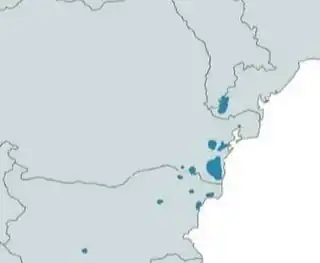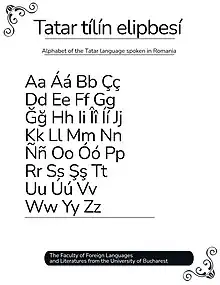Dobrujan Tatar dialect
Dobrujan Tatar or Romanian Tatar (Tatarşa, Татарша or Tatar tílí, Татар тілі) is the Tatar language of Romania. It includes Crimean Tatar and Nogai dialects,[5][6][7][8][9] but today there are no more longer sharp distinction between this dialects and it's mostly seen as a one language.[10][4] This language belongs to Kipchak Turkic languages, specifically to Kipchak-Nogai and is influenced by Turkish and Romanian.[10][4]
| Dobrujan Tatar | |
|---|---|
| Romanian Tatar | |
| Tatarşa or Tatar tílí Татарша or Татар тілі | |
 | |
| Native to | Romania, Bulgaria, Turkey, Ukraine,[1] Moldova[2] |
| Region | Eastern Europe |
| Ethnicity | Dobrujan Tatars |
Native speakers | 70,000 (Dobruja) |
Turkic
| |
| Dialects |
|
| Dobrujan Tatar alphabet (Latin script, Cyrillic script) | |
| Official status | |
Recognised minority language in | |
| Language codes | |
| ISO 639-3 | – |
| Glottolog | dobr1234 |
| IETF | crh-RO |
 | |
 Tatar spoken in Romania is one of the Severely Endangered Languages in Europe[4] | |
Name
In Romania is it commonly called as Tatar language. But in some sources is also seen Romanian Tatar,[10] Dobrujan Tatar,[10] Danube Tatar, Budjak Tatar,[11] Nogai, Nogai-Tatar, Dobrujan Nogai, Budjak Nogai, Crimean Tatar, Dobrujan Crimean Tatar, Authentic Crimean Tatar or Colloquial Crimean Tatar.
Dialects
Tatar language in Romania has three dialects:[10][12]
- The Şól dialect (Şól tílí) spoken by about 70% of Romanian Tatars. It's spoken mainly in the south and center of Constanța and has been heavily influenced by Oghuz.
- The Nogay dialect (Nogay tílí) spoken by about 20% of Romanian Tatars. It's spoken in Tulcea, near and far north of Constanța, and is the most conservative in preserving Kipchak elements.
- The Yalîbolu dialect (Yalîbolu tílí) spoken by about 10% of Romanian Tatars. It's spoken around the cities of Hacıoğlu Pazarcık (Dobrich) and is the closest to Oghuz languages.
They differ mainly in pronunciation, and to some extent in vocabulary.[10]
Phonology
The first book about the phonology of the Tatar language spoken in Romania was published by Taner Murat as „The Sounds of Tatar Spoken in Romania: The Golden Khwarezmian Language of the Nine Noble Nations“ in English language.[4]
The literary Tatar spoken in Romania
Tatar spoken in Romania has two distinct facets existing, interweaving and forming together the literary Tatar language "edebiy Tatarşa". One of these aspects is the authentic Tatar called "ğalpî Tatarşa" or "ğalpak Tatarşa" and the other is the academic Tatar language called "muwallímatşa".
- Academic Tatar language, means writing and pronouncing Arabic and Persian neologisms - occurring mostly in science, religion, literature, arts or politics - in their original form.
- Authentic Tatar language, means writing and pronouncing words, including those of Arabic and Persian origin, by strictly adapting them to the own phonetic system.
Letters

There is a total of 10 letters used to represent determinant sounds of which 9 mark authentic determinant sounds: a, e, i, î, í, o, ó, u, ú while the letter á is used for an academic vowel. The writing system registers authentic consonants with 17 letters: b, ç, d, g, ğ, j,k, l, m, n, ñ, p, r, s, ş, t, z and has three signs standing for the academic consonants: f, h, v. There are also two authentic semivowels: y, w. An old authentic Turkic consonant, the sound /ç/ represented by the letter ⟨Ç⟩ is rarely heard because authentic speakers of Tatar spoken in Dobruja spell it /ş/ as letter ⟨Ş⟩. As the written language most often follows the spoken language shifting ⟨Ç⟩ to ⟨Ş⟩, the result is that in Tatar spoken in Romania letter ⟨Ç⟩ and sound /ç/ are often treated as academic.
Alphabet

For the Tatar language in Romania is Latin alphabet used[13][14] and the diaspora in Ukraine and Moldova uses the Cyrillic script. The Latin alphabet is used with the letters Á, Ç, Ğ, Ñ, Î, Í, Ó, Ş, Ú and the Cyrillic script including the letters Ә, Җ, І, Ң, Ө, Ү, Ў.
Latin
| A a | Á á | B b | Ç ç | D d | E e | F f | G g | Ğ ğ |
| H h | I i | Î î | Í í | J j | K k | L l | M m | N n |
| Ñ ñ | O o | Ó ó | P p | R r | S s | Ş ş | T t | U u |
| Ú ú | V v | W w | Y y | Z z |
Cyrillic
| А а | Ә ә | Б б | В в | Г г | Д д | Э э | Ж ж | Җ җ |
| З з | И и | Й й | К к | Л л | М м | Н н | Ң ң | О о |
| Ө ө | П п | Р р | С с | Т т | У у | Ү ү | Ў ў | Ф ф |
| Х х | Ц ц | Ч ч | Ш ш | Ы ы | І і | Ю ю | Я я |
Status
Education
The Dobrujan Tatar language did get his first alphabet in 1956,[10] it was established as a section in University of Bucharest, the Faculty of Foreign Languages and Literatures in 1957 and also in 1977 it was disbanded.[15] Most of the teachers who taught at the Tatar language department graduated from the Faculty of History and Philology of Kazan State University (Tatarstan - Russian Federation), specializing in Tatar language and literature.[15] In communist period there were brought Tatar books from USSR to educate the Tatar language in Romania, but it did fail. Nowadays is the Tatar language taught in some Romanian schools with own Tatar books.[10][16]
Media
There are some Tatar magazines in Romania, also novels, dictionaries, poetry books, school books and science books.[17][18][10][16] Some of the dictionaries are printed by the help of UDTTMR.[19] In Romanian television broadcasts was also Tatar learning rubrics called „Tatarşa üyrenemĭz“ (Romanian: Învățăm tătărește; "We learn Tatar") and the TV show „Romanya'dan Tatarlar“ (Romanian: Tătarii din România; "Tatars from Romania") showed.[20][21] However, the language is not supported in language keyboards or in language codes.
Official status
The Government of Romania recognises the Tatar community. Also every 5 May is the official Tatar language Day in Romania.[22]
Nilghuin Ismail describes the situation: "Nowadays the Romanian Tatar language is preserved only as spoken language. Even so in accordance with the Parliamentary Assembly of the Council of Europe, in the Recommendation 1201 (1993), on an additional protocol on the rights of national minorities, is stipulated: Every person belonging to a national minority shall have theright to freely use his/her mother tongue in private and in public, both orally and inwriting. This right shall also apply to the use of his/her language in publications andin the audiovisual sector. Despite all these recommendations, in Romania we still do not have literary Tatar language."[10]
See also
- Tatars of Romania
- Dobrujan Tatar alphabet
- Dobrujan Tatar grammar
References
- Національний склад населення України 2001
- Некоторые итоги переписи 2004 года в Молдавии
- "Reservations and Declarations for Treaty No.148 – European Charter for Regional or Minority Languages". Council of Europe. Archived from the original on 8 December 2015. Retrieved 28 December 2016.
- The Sounds of Tatar Spoken in Romania: The Golden Khwarezmian Language of the Nine Noble Nations (Academia.edu)
- https://www.researchgate.net/publication/287996468_Ekstra_Kucuk_Bir_Dil_Olarak_Romanya_Tatar_Turkcesi_As_an_Extra_Small_Language_Romania_Tatar_Turkish
- THE TURKISH LANGUAGE SPOKEN BY THE TURK-TATAR COMMUNITY LIVING IN ROMANIA
- "Общие сведения о татарах Добруджи". Академия наук Республики Татарстан. Archived from the original on 2022-01-19. Retrieved 2022-01-19.
- "Дунайские или румынские татары. Откуда взялись и как живут в настоящее время" (in Russian). Archived from the original on 2022-01-18. Retrieved 2022-01-19.
- "Танер Мурат: Добруджа татарларының ун яшьлек балалары татарча иркен сөйләшә белә" (in Tatar). Tatar-inform. 24 April 2018.
- Ismail, Nilghiun. "Romanian Tatar language communication in the multicultural space".
- "Некоторые итоги переписи 2004 года в Молдавии". www.demoscope.ru. Archived from the original on 2012-01-20. Retrieved 2015-11-23.
- Eker, Süer (2006). Ekstra küçük bir dil olarak Romanya "Tatar Türkçesi" Archived 2012-04-17 at the Wayback Machine
- The translation of the book "Luceafărul" (Mihai Eminescu) by Taner Murat with this scripts
- Latin alphabet used by Taner Murat
- Secția de Limba tătară
- Implementation of the Tatar Language in the Schools of Romania
- UDTTMR Publications
- Books of Taner Murat
- "Dobruca Kırımtatar Ağzı Sözlüğü".
- UDTTMR Rubric; Friday, 18:00 in LITORAL TV (See description)
- UDTTMR TV show; Friday, 18:00 in LITORAL TV (See description)
- Tatar language Day in Romania
External links
- Website of The Democratic Union of Turkish-Muslim Tatars of Romania
- Website of The Cultural Union of Tatars from Romania
- Website of The Democratic Tatar Union
- Website of The Miras Virtual Museum
- As an Extra Small Language Romanian Tatar Turkish
- Romanian Tatar language communication in the multicultural space
- The Turkish Language Spoken by the Turk-Tatar Community living in Romania
- Implementation of the Tatar Language in the Schools of Romania
